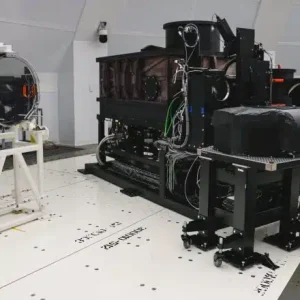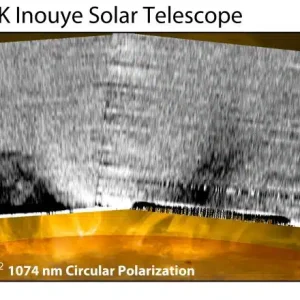The US National Science Foundation (NSF) Daniel K Inouye Solar Telescope, operated by the NSF National Solar Observatory (NSO), has directly mapped the strength of the magnetic field in the solar corona – the outer part of the solar atmosphere that can be seen during a total eclipse – to successfully produce the most detailed maps of the sun’s coronal magnetic fields to date.
Since the 1950s, solar physicists have mapped the magnetic fields on the sun’s surface. However, maps of the magnetic field in the zones above the surface, like the corona, have long been sought as it is in these locations that solar winds and space weather events like solar flares and coronal mass ejections originate. The Inouye Solar Telescope, located near the summit of Maui’s Haleakalā in Hawai’i, now provides the capabilities to meet this need.
The Daniel K Inouye Solar Telescope’s milestone, led by NSO associate astronomer Dr Tom Schad, was recently published in Science Advances, and promises to enhance understanding of the sun’s atmosphere and how its changing conditions lead to impacts on Earth’s technology-dependent society.
Daniel K Inouye Solar Telescope
The US National Science Foundation (NSF) Daniel K Inouye Solar Telescope is operated by the National Solar Observatory (NSO), a US federally funded research and development center focused on solar research, under management by the Association of Universities for Research in Astronomy (AURA). 
The Inouye is the largest solar telescope in the world. With a focus on understanding the sun’s explosive behavior, observations of magnetic fields are at the forefront of the work carried out by this telescope. A combination of an off-axis design, to reduce scattered light, and polarimetery produces the first ongoing measurements of the magnetic fields in the sun’s corona. The Inouye’s 4m mirror provides “unprecedented images from the Sun’s surface to the lower solar atmosphere”, the NSO says. Focusing on small observing changes, the instrument suite gathers images from the sun’s surface to the lower solar atmosphere. The Inouye Solar Telescope reveals features three times smaller than anything scientists can see on the sun today and does so multiple times a second. Not only do the instruments and optical assembly enable spectacular imagery, but they also have incredible spectroscopic capabilities. Observing the specific fingerprints of hundreds of atoms and ions throughout the solar surface and atmosphere is expected to help the researchers explain the dynamic nature of the sun’s behavior.
The Daniel K Inouye Solar Telescope has created its first detailed magnetic field maps of the solar corona using the Zeeman Effect, which measures magnetic properties by observing spectral line splitting. Spectral lines are distinct lines that appear at specific wavelengths in the electromagnetic spectrum, representing the light absorbed or emitted by atoms or molecules. These lines act like “fingerprints”, as they are unique to each atom or molecule, enabling scientists to identify the chemical composition and physical properties of celestial objects by looking at their spectra. When exposed to a magnetic field, like in the sun, these lines split, which gives us an insight into the object’s magnetic properties. Previous attempts at detecting these signals, last reported two decades ago (Lin et al. 2004) lacked the detail and regularity needed for extensive scientific investigation, the observatory explains. In contrast, the Inouye’s capabilities facilitate detailed, regular studies of these signals.
Typically, one can only view the sun’s corona – a region one million times fainter than the solar disk – during a total solar eclipse, when most of the sun’s light is blocked and Earth’s sky goes dark. The Inouye, however, uses a technique called coronagraphy to create artificial eclipses, meaning it can detect extremely faint polarized signals – a billion times fainter than the solar disk.
The Inouye accomplishes this with its Cryogenic Near-Infrared Spectropolarimeter (Cryo-NIRSP), one of the telescope’s primary instruments used to study the corona and map its magnetic fields. This instrument was designed and built by the University of Hawai‘i Institute for Astronomy.
“The Inouye’s achievement in mapping the sun’s coronal magnetic fields is a testament to the innovative design and capabilities of this trailblazing unique observatory,” commented Tom Schad, scientist at NSO and first author of the study. “This breakthrough promises to significantly enhance our understanding of the solar atmosphere and its influence on our solar system.”
Future prospects
“Just as detailed maps of the Earth’s surface and atmosphere have enabled more accurate weather prediction, this thrillingly complete map of the magnetic fields in the sun’s corona will help us better predict solar storms and space weather,” said Dr Carrie Black, NSF program director for the NSO. “The invisible yet phenomenally powerful forces captured in this map will propel solar physics through the next century and beyond.” 
Christoph Keller, director of NSO, remarked, “Mapping the strength of the magnetic field in the corona is a fundamental scientific breakthrough, not just for solar research, but for astronomy in general.” He anticipates that “This is the beginning of a new era where we will understand how the magnetic fields of stars affect planets, here in our own solar system and in the thousands of exoplanetary systems that we now know about.”
Ongoing and future studies will refine diagnostic tools and techniques, leading to deeper insights into the sun’s magnetic environment and its impact on Earth and our solar system.
In related news, the Laboratory for Atmospheric and Space Physics (LASP) at CU Boulder recently enacted a collaborative Space Act Agreement with NASA’s Goddard Space Flight Center to advance research and modeling in the critical field of space weather. Click here to read the full story.



